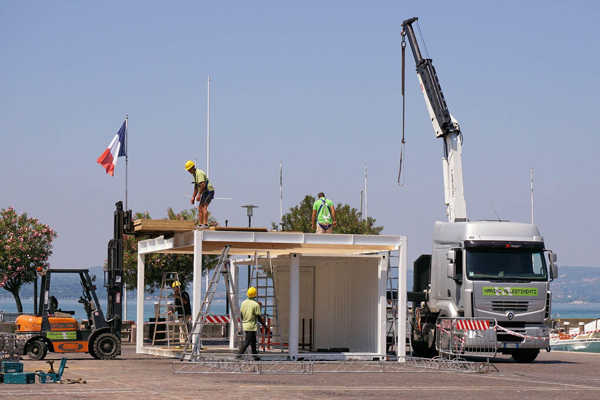For larger renovations you might need a truck to deliver your materials, such as framing timber, larger panels, pavers, and so on. In some cases it could be impossible to get these materials to the right place on your site with just manpower alone, and in others it’s simply more efficient to use machinery. This is why there are two options that are frequently used when delivering building materials: truck loader crane and truck-mounted forklift.
Each has its own advantages and disadvantages and it will depend on the geography and accessibility of your site as to which you can use.
Truck-mounted forklift
The most common truck-mounted forklift is a Moffett forklift. These are a 3-wheel rough-terrain forklift with a loading capacity of up to 3500kg. Some models have 4-way capability which means they can unload a long load of timber from a truck, then turn their wheels sideways to drive sideways with the load.
These forklifts are stored on the back of the truck and can unload and load themselves. They are simple to use and can be driven under power lines (with the mast down) and over moderately rough ground.

The disadvantages are that you are limited to placing objects no more than around 3 metres, and that’s not the full 3500kg either as capacity diminishes in relation to height, and they are no good on steep terrain.
To drive a forklift you need, at minimum, a forklift licence. If you are driving on the road, some countries require that you have a separate qualification (e.g. in New Zealand, this is an F endorsement)
The advantages of using a truck-mounted forklift are that you can transport the load any reasonable distance from the truck and it’s quick.
Truck loader crane
The alternative is a truck loader crane. This is a crane which is mounted either just behind the cab or right at the back of the flat deck of the truck. The crane is commonly a knuckle boom, meaning it has two articulation points, and it can swivel 360 degrees (or thereabouts).
The advantages of a crane are that it can lift a heavier load (depending on the size of the crane and the truck), it can lift a load much higher than a forklift (e.g. lifting roofing materials), and it can place items where a forklift might not be able to go because the terrain is too rough or too steep. Cranes can even place loads through open windows or ranchslider doors.
A crane takes longer to unload because the items need to be rigged properly, i.e. the lifting process in a crane requires more preparation. Cranes also cannot be used near power lines.

Site safety
So, we’ve established that machinery could be delivering items onto your site. What should you do?
The first priority is to make sure that all other trades working on-site know that heavy equipment will be there. You can call a toolbox meeting in the morning to discuss any variations to usual site safety.
The second priority is to make sure that the delivery will be safe. This means that you’ll need to ensure that there is a place to park the truck which does not obstruct traffic on the road or on and off the site, and that you have a place to put the materials that the truck is loading.
The third priority is to ensure that the path between the truck and where the load will be placed is feasible for either the forklift or the truck-mounted crane, whichever is being used.
The truck driver should take care of safety around their immediate work area by using cones and/or barriers and wearing high-vis clothing.
Trucks carrying a heavy load can sink into soft ground, so ensure that their parking spot is relatively level with firm ground. If you need to get a traffic management company, ask the delivery company if they manage this.
Ensure that wherever the materials are stacked, they are safe (i.e. they won’t obstruct anyone else, won’t fall over and won’t be damaged in their location).
Are there other options for receiving heavy goods from a truck?
There are no other convenient mechanical options for unloading larger items from a truck at a building site, unless you have an onsite telehandler or loader (unlikely for small residential projects). You can get several burly people to lift it, or you can use a hand pallet truck or wheelbarrow, but a truck-mounted forklift or a truck loader crane are by far the best option for heavy loads.
The important thing is that you have your products delivered safely and without damage. Don’t rush the driver and don’t lift or move items where they might cause a hazard. Thanks to the organizations linked to above for consulting.
























